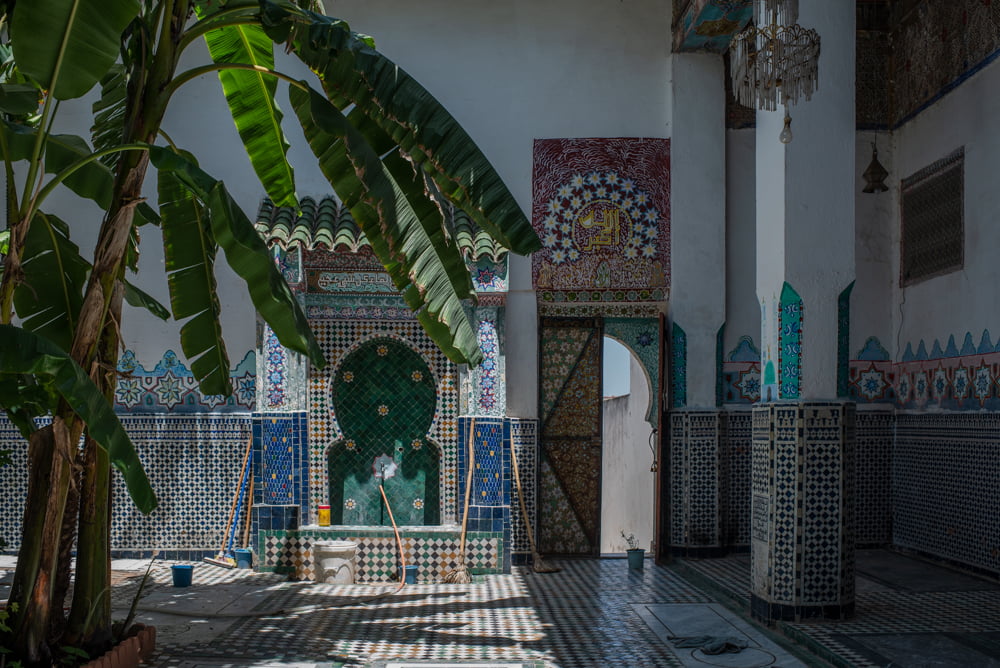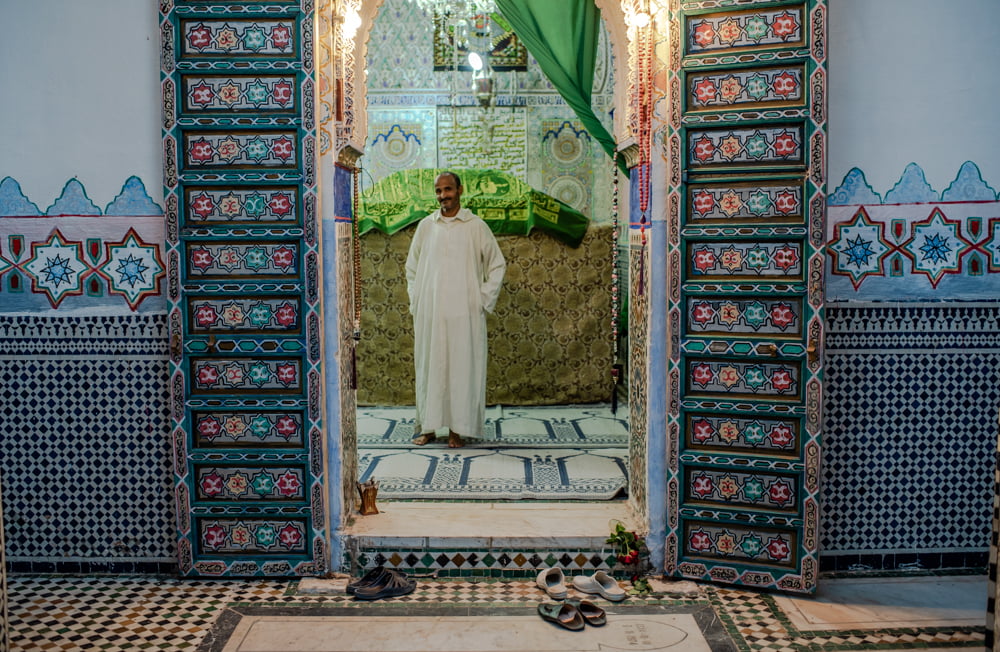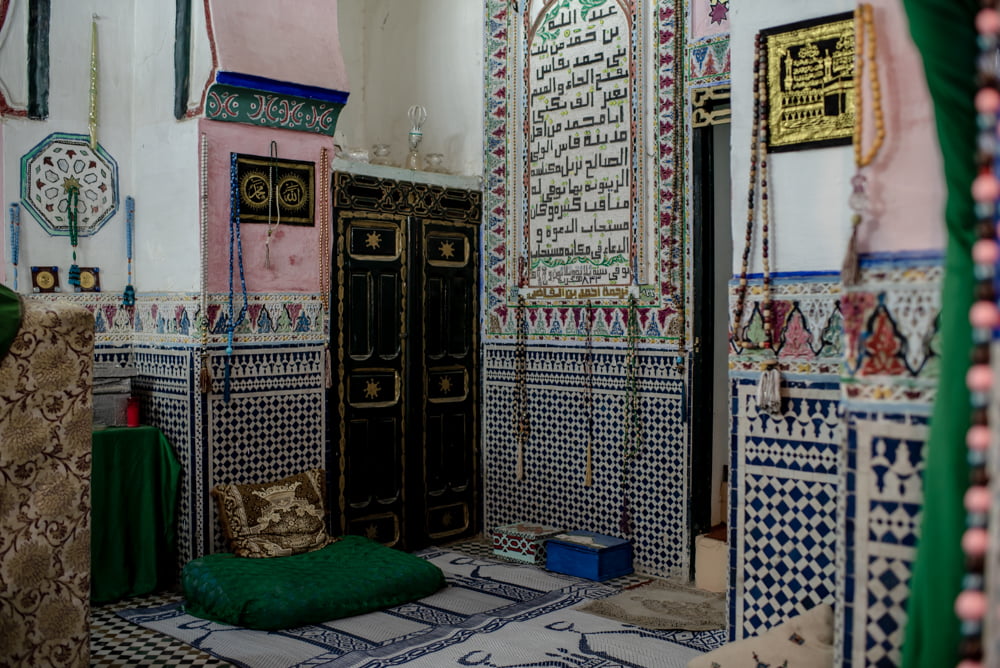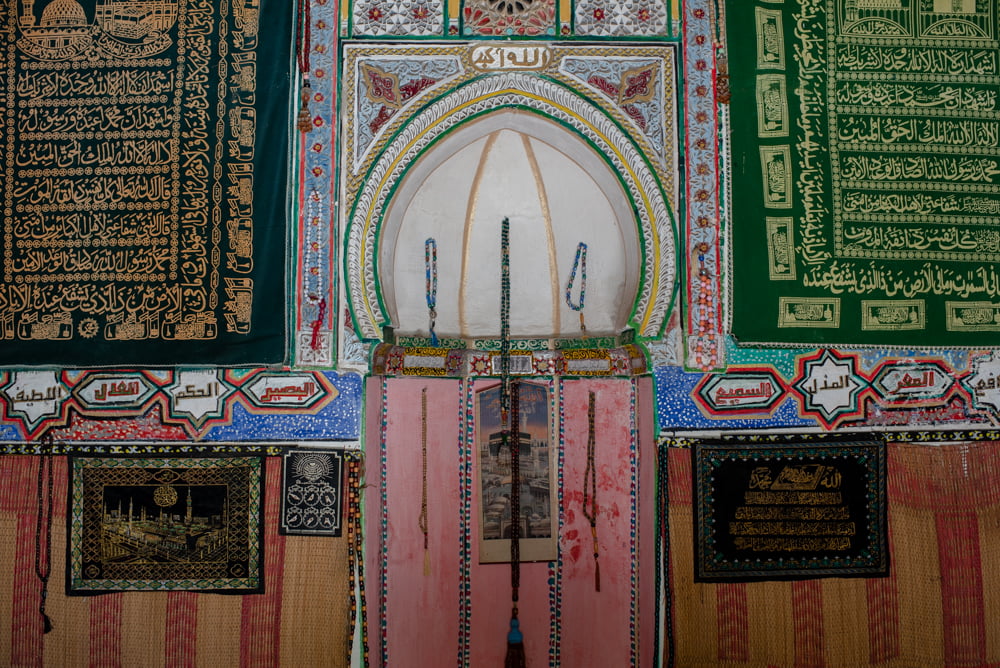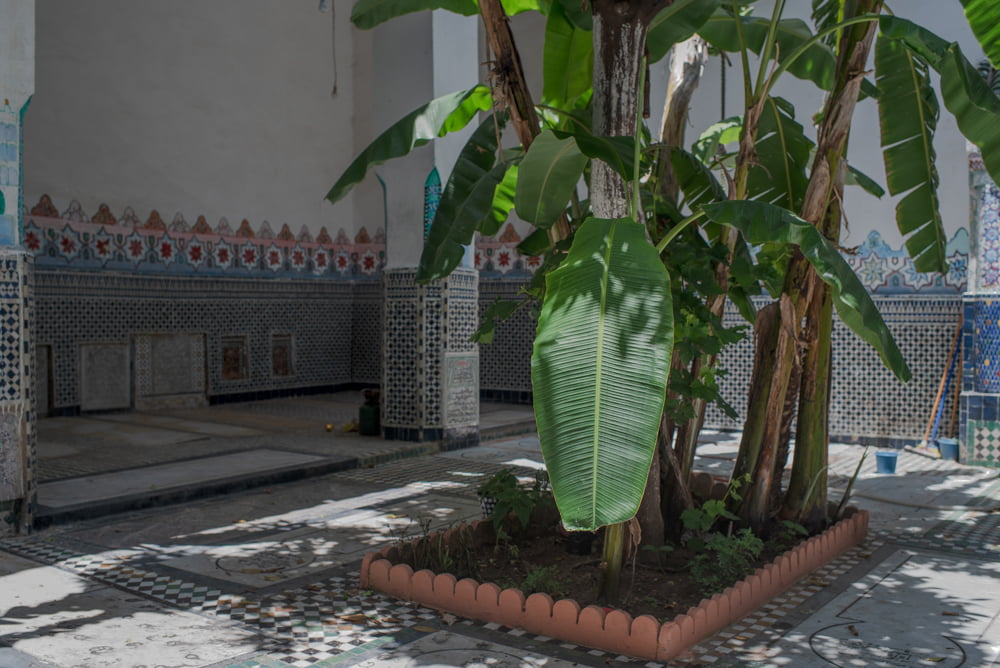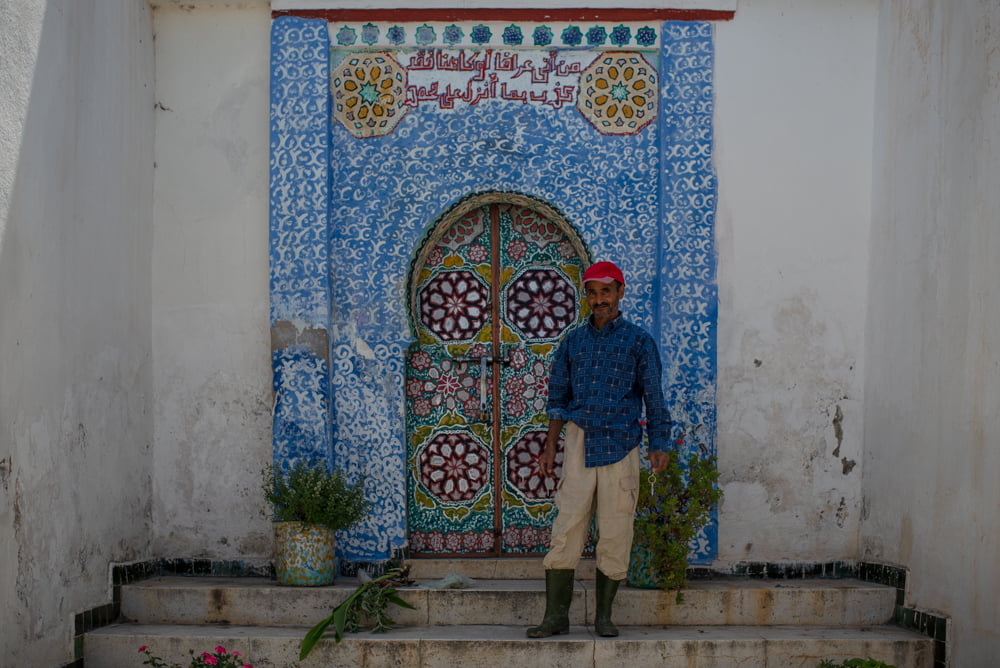Late on my final afternoon in Meknes in early June 2019 I decided to investigate an interesting religious building I had seen whilst travelling to the holy pilgrimage town of Moulay Idriss Zerhoun by bus several days earlier. This building was situated next to a cemetery on the main ring road which surrounds Meknes close to Bab Berdaine.
I walked under Bab Berdaine and out of the Medina. From the ring road the view was uninterrupted across countryside as far as the range of hills in the distance where, on the invisible side and out of sight, Moulay Idriss’ mausoleum nestled within a valley. The landscape was burnished by the early June sun. Beside me, as I walked, cars, motor cycles and buses slowly filed by, their noise destroying an otherwise peaceful afternoon.
After a hundred yards or so of walking beside the old cemetery wall I came to the building set a little off the road. Fronted by a decorated door, which was open, and adjacent to a huge fountain of intricate design it appeared even more grand than I remembered. I walked through the door and made my way up a small tiled slope and then some steps towards another door, this time of bright blue design. This door was also open. Expecting to be rebuffed as a non-muslim, I approached cautiously and a slight black haired ascetic looking man wearing a white gown quickly appeared and, without hesitation, invited me inside.
The door led immediately into the main open courtyard of the complex, where an orange and a banana tree, apparently co-joined, rose into the blue sky. On one side of the courtyard was another elaborately decorated fountain with a collection of besoms laid against it, on the other a brightly painted door which led into the garden cemetery and on the other side a recessed alcove where tombs lay in shadow. All around the walls, above blue tiles which rose waist high, around the fountain and the doors were hand painted designs of stars in reds and blues and greens.
The final and main doorway off the courtyard led through a pair of open decorated cedar doors into the main mausoleum where a large tomb could be seen in the shadows.
The colour and peace instantly overwhelmed me. The man told me in a mix of French and broken English that the shrine was that of a marabout Sufi saint who originated from the sahara region in Algeria, had travelled to Morocco to form his tariqah and had died in the 1500s. The saint’s name was Moulay Abdullah Ben Hamad, and his tomb, as is customary, was mounted on a plinth and covered by a sumptuous cloth. Around the tomb were a myriad prayer beads hanging down and covering the walls swathes of illustrated cloth. A panel of large arabic text provided detail of the life of the saint. On the floor was rich carpets over tiling and a door led from this room into a functioning mosque with a decorated mihrab. As a non-muslim I was not allowed to enter either the mausoleum or mosque room, only to view from the doorway.
He told me his own name was Alaoui Abdelouahed and that he was the priest/gardien at the shrine. Although he did not live here ( he lived at zawiya Alami inside the medina ) he had looked after the shrine for many years and had created all of the designs there himself, painting them all by hand. He told me that he had diplomas in a number of disciplines, including art, which together provided him with authority to create the designs, look after the shrine and also practice as a priest/healer. He said the site retained a congregation and his role was varied. Sometimes it was to facilitate developing a mystical closeness to God through prayer and ritual, host celebrations at auspicious times of the Islamic calendar or within people’s lives ( eg birth, circumcision ) and at other times to treat people when they were sick, especially with emotional sickness.
Whilst in Morocco previously I have seen rituals where music was employed to treat emotional ill health caused by possession and I asked whether sickness might be caused by the action of ‘spirits’, or specifically ‘jinns’. Alaoui confirmed that jinns are problematic and can cause mental illness and distress which he can treat.
Morocco has a long tradition of foqaha ( spiritual healers ) practicing al-‘ilm al-ruhani ( spiritual science ), inscribing and reciting Qur’anic verse to relieve physical and social ailments associated with possession by jinn, curses eg the evil eye and clandestine acts of sorcery ( al-sihr). In severe cases the possessed also consult seers ( shuwwaf) and make annual sacrifices and pilgrimages to saints tombs. As traditional methods become potentially discredited through modernity (though apparently they still remain popular especially amongst the poor and country people ), clients may also seek formal psychiatric and medical care.
He said that as a priest and healer he can treat illness caused by jinn possession with a combination of Quranic prayer, infusions of herbs and exorcism. He showed me a range of herbal infusions in cloudy partially filled plastic bottles which he invited me to smell. He went on to differentiate between Shaytan ( ‘the very big evil’ ) and jinns, which are not so powerful but still mischievous and troublesome. He went on to say that judgement for everybody will occur at the ‘Apocalypse’, I assume implying jinns, as well as humans, will eventually face judgement on the day of reckoning.
According to the Qur’an the jinn are a non-human race created by God before he created humankind. Unlike humankind jinns were formed from smokeless fire and not solid substantive clay. They are invisible, live in a parallel dimension and have free will. In their own dimension they eat and drink, are free to marry, have children, die and are still accountable to Allah for their behaviours. They can occupy and share with humans all spaces public and private, including homes, though often dwell in cemeteries, drains, sewers, deserts, ruins and marketplaces. By nature they are characteristically unpredictable, desirous and vindictive. They have an ability to occupy the minds and bodies of all other creatures, including animals and trees, though this is forbidden to them. Traditionally Moroccans accommodate their potential presence in a variety of ways and situations; for example will address them when entering an empty room, will warn the jinn before they flush hot water down drains where they are believed to dwell, warn children to moderate behaviour in order to not upset them.
Foqaha’s prayers and exorcisms are only one of several religious methods for curing possession by jinn. The others practiced by particular sufi orders ( Gnawa, Aissawa and Hamadsha ) involve developing communication with the jinn in a number of ways including ceremonies utilising extended sessions of music and dance. Once communication has been established negotiations can begin with the jinn to either remain in situ if the presence is considered supportive to the human host, moderate negative behaviours by the jinn which trouble the human host or leave the human host’s body if the jinn is considered entirely negative. Appeasing the jinn might include a pilgrimage to a saint’s tomb, a sacrifice or further communication through music and dance ceremonies. This sacred use of Gnawa music and dance to communicate with a jinn is what I had witnessed before in Essaouira.
We went up to view the skyline from the terrace, but by this time dusk was turning into night and there was little to see other than the lights from the buildings in Meknes on one side and scattered lights from the countryside beyond the ring road on the other. The last soft light of dusk was picking out and making glow the oranges on the top branches of the tree growing up and out of the courtyard. In the gloom Alaoui was telling me about a book on sufism he has authored and about his own sufi master currently living in France who was also an écrivain. It was time for me to leave.
Having aroused my interest, and disappointed to not find any information regarding the Marabout or his tariqah online, I returned again the following day before my evening bus departed from Meknes. I wanted to both obtain better photographs and talk again with Alaoui. On this occasion he was dressed in old clothing, wellington boots and a red cap to protect against against the sun. He said he was going to tend to his garden where his herbs grew. He was happy to chat for a while and in the colourful courtyard made me a pot of tea on coals on an old ceramic bar-b-q, prepared with his own decanted eau de fleur. He wrote down for me the name of the sufi saint plus his own name, address and telephone number so I could be sure I had the correct information. I savoured again the decorated mihrab, the colour and intricate design work in the courtyard and the mausoleum before exploring the cemetery garden where family members of the Saint are buried. Several had their own small mausolea but most were buried in ornate tombs which lay in a dappled patchwork grid on the ground. Some flowers, plants and shrubs were planted throughout and brought splashes of colour to the heat of the cemetery. In places his own hand painted colouring around door frames and other features also brought freshness.
After about an hour he became impatient to leave for his garden and my time within the mausoleum of Sufi Moulay Abdullah Ben Hamad, together with his disciple and erstwhile priest/artist/foqaha Alaoui Abdelouahed, some 400 years after his death, was at an end. We left the zawiya together, he closed and locked the bright blue door behind him, threaded his way through the traffic to the other side of the busy road and disappeared down the slope
For more information regarding jinns, possession, healing and the influence of modernity on these traditional beliefs see Jinn, Islam and Media in Morocco by Emilio Spadola here. I acknowledge this article provided me with some definitive background information.

